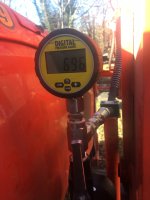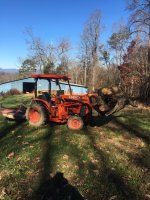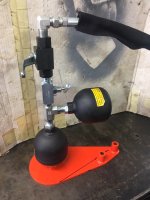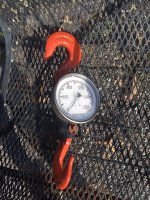Smokeydog
Elite Member
Recently retrofitted a Kubota Soft Ride (KSR) system to fit a M59 loader. Nice upgrade and would highly recommend this option if available. Greatly reduces stress while carrying loads.

Added a permanent pressure gauge at the same time. Anyone else monitoring their loader lift pressure during use? Advice?
Not only did I want another way to evaluate the KSR system but learn more about the dynamics of the hydraulic system. See if I could use it to roughly measure the weight of what I’m picking up. Large loaders at quarries use similar system.

Only on for a few days so trying some experiments to evaluate if this is something that is practical.
Grapple empty 630psi.
Grapple I think is 850#
Need to measure with the grapple off.
How the weight is measured relative bucket pin.
Dead head lift into brush pile, 2600psi. Slightly lower than the 2750-2950 spec. 1400+hours.
Could curl while at max lift 3700psi. Showing how trapped fluid in a circuit can exceed pump relief valve pressure by external force. Curl, grapple, push/pull driving, and bouncing.
Curl effects lift circuit psi. How high you lift. Some loaders have graphs showing lifting capacities along their lifting range. Sitting with engine off, grapple empty but not on ground after using has 1800psi I guess due to thermo expansion. Lot to consider and respect when seeing how much pressure is in the system.
Don’t have many known 500#-ton weights sittings around to calibrate.

Added a permanent pressure gauge at the same time. Anyone else monitoring their loader lift pressure during use? Advice?
Not only did I want another way to evaluate the KSR system but learn more about the dynamics of the hydraulic system. See if I could use it to roughly measure the weight of what I’m picking up. Large loaders at quarries use similar system.

Only on for a few days so trying some experiments to evaluate if this is something that is practical.
Grapple empty 630psi.
Grapple I think is 850#
Need to measure with the grapple off.
How the weight is measured relative bucket pin.
Dead head lift into brush pile, 2600psi. Slightly lower than the 2750-2950 spec. 1400+hours.
Could curl while at max lift 3700psi. Showing how trapped fluid in a circuit can exceed pump relief valve pressure by external force. Curl, grapple, push/pull driving, and bouncing.
Curl effects lift circuit psi. How high you lift. Some loaders have graphs showing lifting capacities along their lifting range. Sitting with engine off, grapple empty but not on ground after using has 1800psi I guess due to thermo expansion. Lot to consider and respect when seeing how much pressure is in the system.
Don’t have many known 500#-ton weights sittings around to calibrate.

